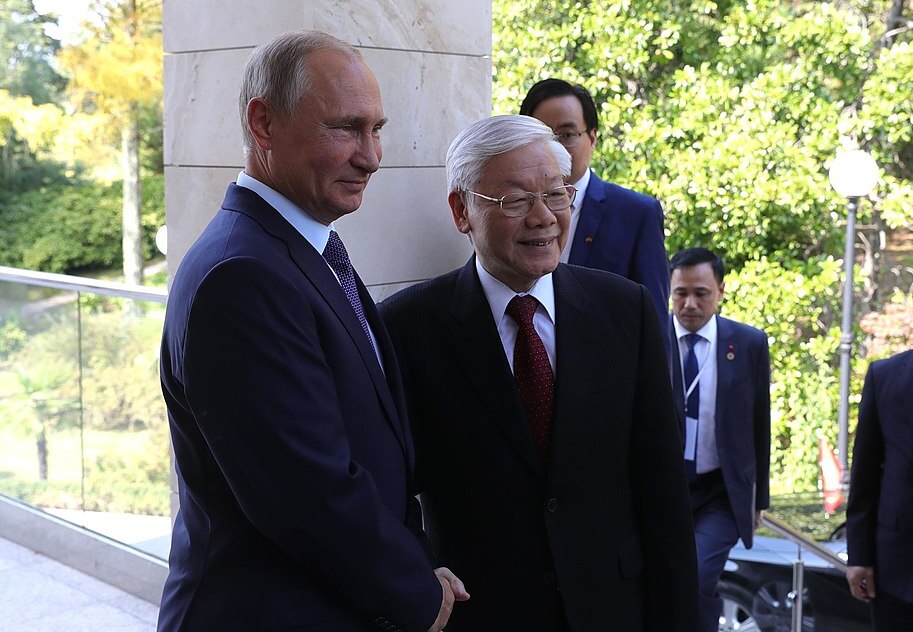Russia is seeking to ensure it has a place at the table in Southeast Asia. Arms exports, as well as the lucrative energy business, seem to be key pillars of the Kremlin’s foreign policy in the region, primarily in Vietnam – a country that has been Moscow’s strategic partner since 2001.
Over the past 20 years, the Kremlin has been gradually increasing its influence in Vietnam, although it is still far from the level of the Soviet – Vietnamese relations; during the Cold War era, the Soviet navy actively used the Cam Ranh military base at an inlet of the South China Sea. Established as a base by the United States during the Vietnam War, Cam Ranh Bay had been used largely by Soviet forces since 1979. In 1984 Vietnam and the Soviet Union signed the agreement on the construction of a military garrison infrastructure in the bay. According to the deal, the constructed facilities were to be operated by the Soviet Navy until 2004. But already in 2002 – less than three years after Vladimir Putin came to power – the Russian fleet left Cam Ranh, transferring all the facilities to the People’s Army of Vietnam. In other words, it was Putin, rather than “drunk Yeltsin” – which is how the Kremlin propagandists often describe late Russian President – who shut down the base that served as the largest Soviet naval facility outside the Warsaw Pact.
Now some Russian analysts hope that Moscow could regain control over the strategically important base, although such an option does not seem very probable. Indeed, Vietnam and Russia aim to further develop their cooperation in maritime security, but that does not mean that Hanoi will allow the Russian Navy to have a permanent base on the Vietnamese territory. Vietnamese policy makers are aware that such a decision would jeopardize the country’s relations with China. Still, it is not improbable that the Russians will be encouraged to occasionally use Cam Ranh Bay’s ship-repair facilities.
On June 11, Russian Defense Minister Sergei Shoigu and his Vietnamese counterpart Phan Van Giang discussed the two countries’ military cooperation. Just 12 days later, Vietnam’s Deputy Minister of National Defense Le Huy Vinh hosted in Hanoi Anatoly Chuprynov, resident representative of the Russian Federal Service for Military-Technical Cooperation. Those meetings clearly suggest that the two nations really do plan to increase their military cooperation. For instance, according to reports, the Kremlin intends to sell the fifth-generation Checkmate fighter jet, worth $25-30 million, to Vietnam. Moreover, two Vietnamese frigates took part in a parade in Vladivostok – a major Pacific port city in Russia overlooking Golden Horn Bay, near the borders with China and North Korea – to celebrate the Russian Navy’s 325th birthday on July 25. They were the only foreign warships that took part in the celebration, which is another sign that Russia and Vietnam are keen to maintain their close strategic ties, primarily in the military sphere.
“Vietnam and Russia have shared common stances on almost all international issues, and have supported each other at regional and global multilateral forums”, said General Secretary of the Communist Party of Vietnam Nguyen Phu Trong.
As Vietnamese Prime Minister Pham Minh Chinh recently pointed out, “the development of relations of friendship and cooperation with the Russian Federation is one of the long-term and strategic priorities of the Socialist Republic of Vietnam.” There is no doubt that Hanoi aims to strengthen political, military and economic ties with Russia and create a counter-balance to growing Chinese influence in the region. However, given that the Kremlin claims to be a strategic partner with both Vietnam and China, Moscow will likely aim to preserve the current balance of power in Southeast Asia, which means that it will not cross Beijing’s “red lines”. A permanent Russian naval base in Cam Ranh Bay could be one of them.
On the other hand, there are indications suggesting that the Kremlin is attempting to gradually regain cultural influence in Vietnam. The study of the Russian language was recently included in the school curriculum of Vietnam, which means that, for Vietnamese schoolchildren, Russian will be their first foreign language. There will be four lessons per week for elementary classes and three lessons per week for high school and senior classes. It is worth noting that in Syria – the only country out of the post-Soviet space that still hosts a Russian naval base – Russian has become the second foreign language taught in schools. Still, given that after the collapse of the USSR there has been a significant decline in Vietnamese youth learning the Russian language, it remains to be seen how successful will be the Kremlin’s attempts to increase its “soft power” in the country.
For the foreseeable future, Vietnam will remain one of Russia’s closest partners in Southeast Asia and the two nations will undoubtedly keep developing their economic cooperation, as well as military ties. Moscow, however, will by no means sacrifice its relations with Beijing in order to additionally strengthen its positions in the South China Sea, which means that Russia and Vietnam are expected to keep following their pragmatic policy of balancing in the complex security environment of Southeast Asia.
Image credit: kremlin.ru

